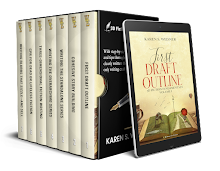Oldies But Goodies
{Put This One on Your TBR List} Book Review
Subseries 2: The Liveship Traders Trilogy (The Realm of the
Elderlings)
by Robin Hobb
by Karen S. Wiesner

Be aware that there may be spoilers in this review.
Robin Hobb is the author of The Realm of the Elderlings. Within this umbrella series, she's written five "miniseries" and numerous short stories. In previous Alien Romances Blog reviews, I covered The Inheritance & Other Stories, which contains a couple Realm of the Elderlings offerings. I also reviewed the first trilogy of novels within this series, The Farseer Trilogy. After recovering from the intensity of that first offering, I took a month or so off before I could get myself to read anything else the author has written within this overarching saga. Following that break, I was able to read two miscellaneous novellas in the series, "The Willful Princess and the Piebald Prince" and "Words Like Coins", and those reviews have also been posted previously on this blog.
Almost immediately following that, I started reading the second trilogy set, The Liveship Traders Trilogy. Technically, I'm reading the subseries in The Realm of the Elderlings in order of publication, not the suggested reading order. The reason I'm doing that is that I sometimes feel like an author makes the most sense of a series by writing the installments as they come to her--even if particular stories don't fit in chronologically with what's come before. I figure if the author gained understanding of it that way, then it's also how I as the reader will best piece it together as well.
The Farseer Trilogy was focused on Fitz, the illegitimate son of Prince Chivalry of the royal line presiding over the Six Duchies. In that first subset, we learned something of the Elderlings (including dragons) and their ancient cities and settlements around the world, especially in the Rain Wilds.
(The) Liveship Traders Trilogy
includes:
Ship of Magic, Book
1 (published 1998)
(The) Mad Ship, Book
2 (published 1999)
Ship of Destiny, Book 3 (published 2000)
In this second subseries, we move away from the royal Farseer lineage and problems within the nobility to something very different. The main setting is Bingtown, a colony of Jamaillia, and deals with "liveships". Liveships are built from wizardwood, which isn't actually wood but the outer cocoon of a sea serpent that was in the process of transforming into a dragon. These logs were buried in the destroyed city of the Elderlings in the Rain Wilds and found by traders who excavated the ruins for valuable, magical artifacts. After three family members die on board, a liveship ship "quickens" and becomes a living, sentient ship. From that point on, these merchant ships have consciousness all their own. With supernatural properties, liveships are the most coveted of all in the realm. The liveship of the family that paid to have it created becomes deeply bonded with all generations of their owners. Once upon a time, owning such a rare and special ship all but guaranteed prosperity for a trader. Not so any longer.
Liveship traders have fallen on hard times because of the war in the north (detailed in The Farseer Trilogy). Trade is the lifeblood of Bingtown and it seeks independence from Jamaillia and Chalced in particular, not wanting to deal in raiding or slave trading. But a selfish, short-sighted, pleasure-seeking Satrap who controls trade for the realm demands that tradition must change with the times. Meanwhile, pirates, migrating sea serpents, a slave rebellion, and a newly hatched dragon complicate things.
In Ship of Magic, Book 1, the main focus is on Althea Vestrit. Her family holds to their contracts and traditions with a death grip until the male head of their family passes away. Althea is the younger daughter and has given her life to their liveship Vivacia. She fully anticipates becoming the captain of the ship someday. However, her mother talks her father out of it, something she soon regrets, just before his death. The eldest daughter is married to a Chalcedean sailor, Kyle Haven, and he gains control of Vivicia after the elder male Vestrit's death, turning her into a slaver vessel. Kyle forces his oldest son Wintrow, who has been training as a priest of Sa for years, to become a sailor because a direct line of the family must always be aboard when a liveship sails.
When she's forced off Vivacia permanently by her sister's pompous, boneheaded husband, who's also been given complete control of the family fortune, Althea leaves Bingtown to find a way to retake her ship. Her family scrambles in her absence. Malta, the manipulative, self-seeking young daughter of Althea's sister, insists on being treated as a woman of marriageable age though she hasn't had the proper training and is barely old enough to be out of pigtails. A series of greedy, spoiled choices on her end have her abruptly being wooed by Reyn, the youngest son of the Rain Wilds trader that provided Vivacia. Althea's family remains indebted to them for the ship, but a marriage between the families could mean the Vestrit's financial situation doesn't prove as dire as it's rapidly becoming.
Althea is wroth at all that's befallen her. Her only allies in regaining control of Vivacia are her old shipmate, roguish Brashen Trell; a mysterious Bingtown woodcarver named Amber; and the Paragon, a notoriously mad liveship owned but essentially abandoned by the Ludluck family. Paragon can't remember how he got the way he is--insane and beached at Bingtown for the past thirty years.
Meanwhile, Captain Kennit is a pirate following a prophecy that tells him he'll become King of the Pirate Isles if he can capture a liveship. But first, on the advice of his first mate, he becomes the hero of slavers when he begins capturing slaver vessels and liberating them.
As with the subseries that came before, these books are undeniably massive, and very introspective and slow-moving. The sheer number of characters thrown in almost from the first page of Book 1 became a chore to keep track of easily. Even the points of view of a tangle of sea serpents following the liveship in search of "She Who Remembers" are included in these books.
While reading the first book, I kept wondering how in the world these seemingly disparate plotlines could possibly converge and make any sense. But they actually did--and explosively. Ship of Magic established the plots, and they were all just the first brutal wave of a hurricane of events and players. As intense as the first 832-page mass market paperback (mmp) was, it was also wholly gripping. I was immersed in each and every aspect. As soon as I finished it, I jumped headfirst into Book 2 despite that I was rapidly becoming exhausted.
(The) Mad Ship starts where Book 1 left off, continuing all the plotlines. Althea learns from Brashen that Vivacia has been claimed by Captain Kennit, and she determines to retake her. Althea and Brashen's relationship is strained due to unresolved feelings between them. Further complicating the situation is her recent marriage proposal from the son of another liveship trader. She's been working aboard that family's liveship Orphelia in order to prove she has what it takes to be captain of her own ship. Meanwhile, Amber is determined to save Paragon with help from Althea and Brashen, and the mad ship begins to remember the traumatic events that led to his madness.
In an attempt to save himself and his father, who are hostages aboard the Vivicia, Wintrow heals Kennit. The pirate captain begins to recover from having his leg bitten off by a sea serpent. Kennit's bond with Wintrow and Vivicia increases. Elsewhere, the Jamaillian Satrap intends to sail to Bingtown and force the traders to bend to his will. The corruption in Bingtown is forcing Old Traders to compromise on nearly every front but rebellion is afoot and one of the Satraps own "heart companions" (traditionally, advisors) schemes to deal fairly with Bingtown traders, though a trauma experience en route changes her for a time and makes her self-protective at any cost. Readers also begin to learn more about Captain Kennit's past, his connection to Paragon, and why his pirate heart is so justifiably black. Also, Althea, Brashen, Amber, and other Bingtown traders begin to outfit Paragon for sailing once more in order to retake Vivicia.
Finally, Malta becomes even more nefarious in her quest to secure the rich, extravagant life she feels entitled to and manipulates on many fronts to see her selfish ends achieved, playing two men in seeking her hand at once and doing her bidding by saving her beloved father Kyle.
Reyn has fallen for Malta, but part of his mind is ensorcelled by the very last dragon in existence. She remains cocooned in the wizardwood trapped in the Elderlings ruins. Reyn longs to free it, but to bring it out of where it's all but buried would be a monumental task requiring many men. No one else wants to see a dragon reintroduced into the world for fear it'll seek to destroy instead of coexisting or even helping them. Malta is also able to communicate with the dragon through the trinket Reyn gave her from the ruins. The dragon promises Malta anything she wants in exchange for her help in freeing her. A schemer like Malta thinks of nothing beyond her own desires. If she unleashes a volcanic explosion upon the world in the process, what does it matter to her as long as she gets what she wants?
At 864 pages in the mmp, this middle story was both even more overwhelming than the last and impossibly more engaging.
The final book of the trilogy, Ship of Destiny, had another daunting 800 pages (mmp). All the twists and turns that have been playing out in the last two books slowly resolve in a way that I heartily approved of and had been hoping for. The bad guys got what they deserved, the good found victory, and many characters realistically made a transition to become heroes instead of villains in the course of the trilogy. The climax wasn't a single action scene but a process that took at least a full quarter of the end of Book 3, including exciting peaks and emotionally satisfying valleys.
As mind-blowing as this trilogy was, I won't deny that I was almost too tired to enjoy the final tale the way I would have if the endeavor hadn't been so daunting. How I wish the author had chosen to divide each installment into three or four books instead of one massive, overwhelming tome! A twelve to sixteen book series of manageable volumes would have been much more enjoyable for me, not to mention less mentally (and physically--the huge paperbacks became hard for me to hold for any great length of time, cutting down on my ability to read faster) taxing. There's simply so much here, I sometimes felt while reading the three books that my head might explode with it all.
While I originally thought I wouldn't be a fan of this second trilogy because the main character Fitz in the first subseries doesn't really factor into them, I ended up liking The Liveship Traders Trilogy even more than The Farseer Trilogy, which is saying a lot. I loved them both. I'm apparently not the only one who feels that way. George R. R. Martin describes it as "even better than the Farseer Trilogy—I didn’t think that was possible". It's apparently also a favorite of author Orson Scott Card.
Not surprisingly, this series has been compared to A Song of Ice and Fire--not in content, but in execution. (The two authors are friends.) Hobb has a similar manner as Martin of writing a story almost as if she's setting down the facts in a history book and not flinching as she establishes every last, excruciating detail just as raw and painful as it gets. Her characters are so realistic and life-like you can't help becoming enmeshed in their lives--sometimes, whether or not you actually want to be. There are a lot of villainous characters in this trilogy, but they're not through and through evil. The reader is given not just a one- or even two-dimensional portrayal of them, but the full three dimensions. Some of those aspects aren't particularly pretty or redeemable, which might be difficult for some readers to stomach. Nevertheless, always, the characters are made understandable. And that's even better. You may dislike or even hate them, may be shocked or sickened by the things they do and say, but you can at least understand the makeup of the characters and what drives them. I do have to warn you that there were several rapes in this series. None of them was detailed or gratuitous--the author handled them skillfully--but beware those who are sensitive.
I can't wait to find out where all this is going in the wider world Hobb has created in The Realm of the Elderlings. I'm open to any direction at this point, as long as there's more of everything I've come to love. All this said, I do wish entertainment producers would make a series of this. Like A Song of Ice and Fire, The Realm of the Elderlings would be amazing in the form of several movies or a TV series.
Incidentally, I read in many articles posted on Wikipedia concerning The Realm of the Elderlings that the character of Amber in Liveship Traders supposedly played the part of the Fool in the Farseer Trilogy (though no sources for where they came by this information are given), but I will say that I didn't see actual reference to that being definitively the case in the specific books for this subseries. In other words, it didn't explicitly spell out, "I'm Amber in The Liveship Traders Trilogy; previously I was the Fool at court in The Farseer Trilogy." Maybe I missed something because there was simply too much here for that not to be a possibility. Make of this what you will. Maybe it becomes important later on in The Realm of the Elderlings. I'm really not sure at the point I am in traversing this world.
In this second subseries trilogy, I learned much more about the Elderlings and the Rain Wilds than previously. That's definitely the overarching plot in all the subseries that keeps me coming back eagerly for more. Here, dragons are reintroduced into the world with humans aiding them. There's also a bit of a disturbing implication that the dragons so influence humans that they're physically and mentally changed as a result--possibly outside of their own wills. In any case, I look forward to more expansion on all of this in further installments of The Realm of the Elderlings.
Unfortunately, I just read in excess of 2400 pages with this subseries. I'm finding I need another lengthy break before I can start on the third subseries, The Tawny Man Trilogy.
Karen Wiesner is an award-winning,
multi-genre author of over 150 titles and 16 series.
Visit her website here: https://karenwiesner.weebly.com/
and https://karenwiesner.weebly.com/karens-quill-blog
Find out more about her books and see her art
here: http://www.facebook.com/KarenWiesnerAuthor
Visit her publisher here: https://www.writers-exchange.com/Karen-Wiesner/



































No comments:
Post a Comment